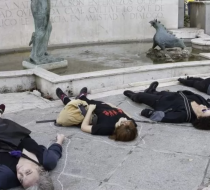2015 Die-In Protest Against Gender Violence Favorite
On September 2nd 2015, a die-in protest to advocate against gender violence was carried out by a group called Women in Black (Olmedilla, 2015). This form of protest was likely inspired by other die-in protests in Spain and represented Spanish women who have died due to domestic violence (DV). A group of women dressed in black clothing gathered on the streets of Madrid. One by one they fell to the ground and lay there, acting dead. Others traced their “dead” bodies on the ground in white chalk, as seen in Image 1. This protest was carried out by the Women in Black of Madrid, who are a community of feminist, antimilitarist, and pacifist women (Women in Black, 2012). They publicly state their positions on social issues in Spain and globally, and as feminists, they oppose patriarchal societies that oppress women. Through non-violent civil disobedience actions, they work to end violence, and their 2015 protest against gender violence was one example of this.
Back in 1939 when the Francoist dictatorship was in power, Francisco Franco took away all women’s rights and imposed a patriarchal society (Chipchase, 2022). For example as Chipchase (2022) explained, women had “no legal rights to work, own property, or get divorced”. After Franco died in 1975, feminist groups and politicians worked to regain equal rights and rid the country of the ingrained “machista” attitudes leftover from the dictatorship (Chipchase, 2022). Once Spain developed as a democracy, they worked to establish women’s rights and integrated policies to ensure that women are protected and treated equally. This included implementing the “Integrated Law” which funded the Government Delegation of Violence Against Women and a State Pact committing to eradicating gender violence. Spain was also the first European country to begin recording all femicides. Even though Spain is seen as a benchmark for equality, progress must continue to be made. Studies have shown that there’s an increased risk for DV where “machista” attitudes are reinforced, and these views are still present in Spain today (Chipchase, 2022). In the few years prior to the Women in Black demonstration, the prevalence of DV in Spain was 43% for emotional abuse, 8% for physical abuse and 12% for sexual abuse (García, 2012). In the past decade, approximately 700 women have been killed as a result of gender violence, but the annual deaths have slowly decreased since the 2015 protest (Signes, 2013). The Women in Black protest reminds the public that gender violence remains a prevalent issue and even though current situations have improved, there are still far too many incidents reported each year.
This protest is both artistic and a form of activism. The physical action of drawing the shapes of women’s bodies to illustrate women who are dead on the ground make this protest artistic, and the meaning behind the bodies bring the activist element into it. Overall, their aim was to combine the two to bring awareness to the ongoing issues of gender violence in the country through a performative action.
References
BBC. (2015, November 7). Violence against women: Madrid stages big protest march. BBC. Retrieved December 4, 2022, from https://www.bbc.com/news/world-europe-34756378
Chipchase, J. (2022, March 8). Women's Day: How Spain became a pioneer in women's rights but still has a long way to go - Olive Press News Spain. The Olive Press. Retrieved December 4, 2022, from
https://www.theolivepress.es/spain-news/2022/03/08/international-womens-... n-became-a-pioneer-in-womens-rights/
Delegación del Gobierno contra la Violencia de Género. (n.d.). Delegación del Gobierno contra la Violencia de Género. Retrieved December 5, 2022, from
https://violenciagenero.igualdad.gob.es/
García, C. (2012). VIOLENCE AGAINST WOMEN: THE SPANISH RESPONSE. World Health Organization (WHO). Retrieved December 4, 2022, from
https://apps.who.int/iris/bitstream/handle/10665/333033/Eurohealth-18-2-...? sequence=1&isAllowed=y
Olmedilla, R. G. (Director). (2015). Women In Black en Madrid [Film]. https://www.youtube.com/watch?v=L-hPbnxXuT4
Signes, A. (2013, November 3). 700 mujeres muertas por violencia de género en la última década. El Mundo. Retrieved December 7, 2022, from https://www.elmundo.es/espana/2013/11/03/52766e7363fd3d62298b456e.html
Women in Black. (2012, April). A BRIEF HISTORY OF WOMEN IN BLACK Women in Black dates its birth to non-violent civil disobedience actions carried out by women. Mujer Palabra. Retrieved December 4, 2022, from https://www.mujerpalabra.net/activismo/mdnmadrid/pages/articles/Herstory... May2012.pdf







